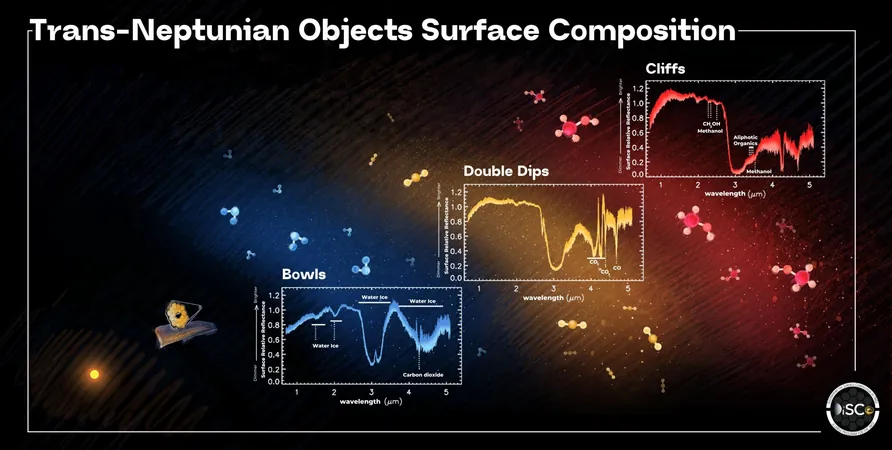
Unveiling the Cosmic Past: Webb Telescope Highlights the Secrets of Trans-Neptunian Objects
2025-01-02
Author: Wei
Trans-Neptunian Objects (TNOs) are fascinating celestial bodies orbiting the Sun beyond the realms of Neptune and Pluto. These icy, dark entities harbor clues about the nascent solar system, making them a treasure trove for scientists seeking to unlock the history of our cosmic neighborhood. However, their small size, substantial distance, and dim visibility have historically made the study of TNOs quite the challenge.
Recent groundbreaking research, utilizing the advanced capabilities of the James Webb Space Telescope (JWST), has successfully captured the spectra of an impressive 54 TNOs. This monumental study has unveiled a diverse array of TNO types, previously unseen and unclassified, based on their spectral characteristics. The research identifies three distinct categories among these celestial objects:
1. Double-Dip TNOs:
Dominated by carbon dioxide ice, these objects are the most prevalent among the surveyed TNOs.
2. Cliff-Type TNOs:
Reddish in hue, these TNOs are rich in nitrogen molecules and complex organics, suggesting a unique chemical history.
3. Bowl-Type TNOs:
Featuring dark, dusty surfaces, these objects are abundant in water ice and offer insights into the conditions of the solar system's outer regions.
The study proposes that these categories emerged due to varying “ice lines” that existed in the early solar system. Essentially, at different distances from the Sun, temperatures were conducive to different types of ice formation—water ice close to the Sun, followed by carbon dioxide ice further out. This implies that these TNOs formed at varying distances from the Sun, likely prior to the dramatic migrations of the larger planets, which are a significant part of our solar system's history.
Interestingly, the correlation between TNO spectral categories and their orbital types reinforces this theory. For instance, cold classical TNOs, found at the outer edges of the planetary disk, predominantly belong to the cliff-type category.
Moreover, the research establishes connections between TNOs and centaurs—planetoids that orbit between Jupiter and Saturn. Although their spectra differ considerably from TNOs, many centaurs share notable features with specific TNO categories. An example is the centaur Thereus, which aligns with the bowl-type classification, while others, like Okyrhoe, defy standard categorization. This suggests that some centaur planetoids likely originated as TNOs that migrated inward over the eons, and others may represent comets that transitioned into centaurs following near encounters with the massive planets.
Looking ahead, the research team aims to obtain even more detailed spectral data on TNOs. This comprehensive analysis could illuminate the specific histories of each TNO category and their interplay with the early evolution of our solar system, potentially reshaping our understanding of planetary formation and migration.
As scientists continue to delve into the mysteries of TNOs, one thing becomes clear: the depths of our solar system hold secrets waiting to be uncovered, promising revelations that could transform our perception of cosmic history!

 Brasil (PT)
Brasil (PT)
 Canada (EN)
Canada (EN)
 Chile (ES)
Chile (ES)
 Česko (CS)
Česko (CS)
 대한민국 (KO)
대한민국 (KO)
 España (ES)
España (ES)
 France (FR)
France (FR)
 Hong Kong (EN)
Hong Kong (EN)
 Italia (IT)
Italia (IT)
 日本 (JA)
日本 (JA)
 Magyarország (HU)
Magyarország (HU)
 Norge (NO)
Norge (NO)
 Polska (PL)
Polska (PL)
 Schweiz (DE)
Schweiz (DE)
 Singapore (EN)
Singapore (EN)
 Sverige (SV)
Sverige (SV)
 Suomi (FI)
Suomi (FI)
 Türkiye (TR)
Türkiye (TR)
 الإمارات العربية المتحدة (AR)
الإمارات العربية المتحدة (AR)